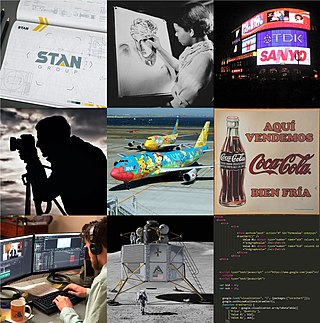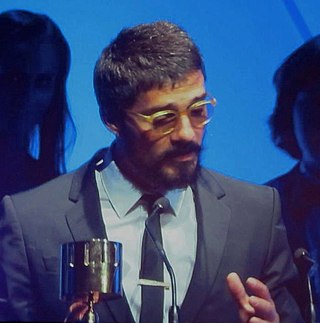A film crew is a group of people, hired by a production company, for the purpose of producing a film or motion picture. The crew is distinguished from the cast, as the cast are understood to be the actors who appear in front of the camera or provide voices for characters in the film. The crew is also separate from the producers, as the producers are the ones who own a portion of either the film studio or the film's intellectual property rights. A film crew is divided into different departments, each of which specializes in a specific aspect of the production. Film crew positions have evolved over the years, spurred by technological change, but many traditional jobs date from the early 20th century and are common across jurisdictions and filmmaking cultures.

Graphic design is a profession, academic discipline and applied art whose activity consists in projecting visual communications intended to transmit specific messages to social groups, with specific objectives. Graphic design is an interdisciplinary branch of design and of the fine arts. Its practice involves creativity, innovation and lateral thinking using manual or digital tools, where it is usual to use text and graphics to communicate visually.

Leisure Suit Larry is an adult-themed sex comedy video game series created by Al Lowe. Drawing inspiration from Softporn Adventure, the Leisure Suit Larry series centers on Larry Laffer—a middle-aged man known for his balding head, penchant for double entendre, and iconic leisure suits. The stories typically focus on his unsuccessful attempts to seduce young women, portraying him as an unsuccessful pickup artist. A common link between the games are Larry's explorations of luxurious and cosmopolitan hotels, ships, beaches, resorts, and casinos.

A storyboard is a graphic organizer that consists of illustrations or images displayed in sequence for the purpose of pre-visualizing a motion picture, animation, motion graphic or interactive media sequence. The storyboarding process, in the form it is known today, was developed at Walt Disney Productions during the early 1930s, after several years of similar processes being in use at Walt Disney and other animation studios.
Concept art is a form of visual art used to convey an idea for use in films, video games, animation, comic books, television shows, or other media before it is put into the final product. Concept art usually refers to world-building artwork used to inspire the development of media products, and is not the same as visual development art, though they are often confused.
A creative director is a person who makes high-level creative decisions; oversees the creation of creative assets such as advertisements, products, events, or logos ; and directs & translates the creative peoples who produce the end results. Creative director positions are often found within the television production, graphic design, film, music, video game, fashion, advertising, media, or entertainment industries, but may be found in other creative organizations such as web development and software development firms as well.

Motion graphic design, also known as motion design, is a subset of graphic design which combines design with animation and/or filmmaking, video production, and filmic techniques. Examples include kinetic typography and graphics used in film and television opening sequences, and station identification logos of some television channels.

Robert Frank Camp is an American animator, writer, cartoonist, comic book artist, storyboard artist, director, and producer. He has been nominated for two Emmys, a CableACE Award, and an Annie Award for his work on The Ren & Stimpy Show.
Paul Bernard Rudish is an American animator, storyboard artist, writer, and voice actor, originally known for his art, writing, and design work at Cartoon Network Studios on series created by Genndy Tartakovsky. He went on to co-create the series Sym-Bionic Titan and, in 2013, developed, wrote, storyboarded, executive produced, and directed a revival of Mickey Mouse short cartoons.
Previsualization is the visualizing of scenes or sequences in a movie before filming. It is a concept used in other creative arts, including animation, performing arts, video game design, and still photography. Previsualization typically describes techniques like storyboarding, which uses hand-drawn or digitally-assisted sketches to plan or conceptualize movie scenes.
A storyboard artist creates storyboards for advertising agencies and film productions.

The Animation Workshop is an animation school housed in the former military barracks in Viborg, Denmark. It is a part of VIA University College's School of Business, Technology and Creative Industries. Since the late 1980s, The Animation Workshop has educated and trained animators for the Danish as well as the international animation, computer game and visual effects industry. The Animation Workshop has a strong international network of artists, professionals, companies, funding institutions and partner schools. Teachers and students come from Denmark and the rest of the world, and all classes are conducted in English.
Chance Thomas is an American composer, author, and entrepreneur. As a composer, he creates original music for animation, video games, movies, television, and virtual reality. His music has received critical acclaim and commercial success, including an Oscar, an Emmy, and billions of dollars in sales worldwide.
Dan Kuenster is an American character animator and director, who worked for Walt Disney Animation Studios, BrainPower Studio and Sullivan Bluth Studios, before pursuing educational multimedia projects. He is also formerly Executive Vice President of Design and Animation at Istation in Dallas, Texas.
Game art design is a subset of game development involving the process of creating the artistic aspects of video games. Video game art design begins in the pre-production phase of creating a video game. Video game artists are visual artists involved from the conception of the game who make rough sketches of the characters, setting, objects, etc. These starting concept designs can also be created by the game designers before the game is moved into actualization. Sometimes, these concept designs are called "programmer art". After the rough sketches are completed and the game is ready to be moved forward, those artists or more artists are brought in to develop graphic designs based on the sketches.
The VFX creative director is a position common in films, television programs, and computer games using a large amount of visual effects (VFX).
Harley Jessup is an American production designer and visual effects art director who has been nominated for two visual effects Academy Awards, and won once. Currently working at Pixar Animation Studios, Jessup has served as production designer for Monsters, Inc., Ratatouille, Cars 2, Presto, The Good Dinosaur and Pixar's animated feature, Coco. Before coming to Pixar, Jessup was production designer on Walt Disney Pictures' James and the Giant Peach.
Phil Trumbo is an American art director, graphic designer, and film director. He is professor and department chair of digital gaming and media at the Kirkland Campus of Lake Washington Institute of Technology and is the creator of multiple video games.

Alberto Mielgo is a Spanish director, artist, and animator. His accolades include an Academy Award, four Emmy Awards and two Annie Awards. Mielgo was an Art Director at Disney's Tron: Uprising (2013) and made his debut as a director with animated short film "The Witness" (2019) created for Netflix anthology: Love, Death & Robots.









